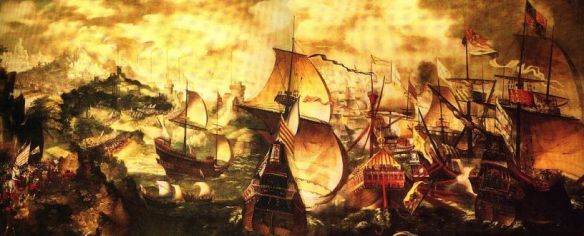
English galleon model: Tvbanfield at en.wikipedia, Public domain, via Wikimedia Commons
A type of 16th century ship known as a “galleon” is featured in my nautical fiction book Voyage of Reprisal. A galleon was a middling-to-large sized, four-masted sailing vessel without oar propulsion. She had square sails on two forward masts and triangular-shaped lateen sails on two aft masts. This arrangement helped galleons sail well before the wind but also up to 70 degrees against the direction of the wind. Although galleons retained fore and stern castles, these superstructures were smaller and more streamlined than that found on other ship types.
Galleons had a narrower width to length ratio (keel length three times breadth) than the round hulled, square-rigged “great ships,” carracks or naos that were designed primarily as cargo carriers. This allowed the galleon to be swifter (up to eight knots speed) and have more nimble sailing properties while still being able to carry a large cargo when used as a merchant vessel. For these reasons, the English favored use of the galleon for armed trading ventures in prohibited waters claimed by Spain in the New World and in the corsair-infested waters of the Mediterranean.
Galleons had a dedicated gun deck running from bow to stern which allowed her to be heavily armed with laterally firing artillery, unlike most cargo ships and all galleys. When called to fight, galleons were the preeminent warship preferred by the Elizabethan navy. The English favored the galleon’s stand-off artillery capability and eschewed the old fashion boarding tactics still favored by arch enemy Spain which benefitted from high castles.
The galleon was an outgrowth of the “galleass” which was invented by the Mediterranean Catholic powers to help fight the time-honored galleys of the Ottoman Turks. Unlike a galley (which depended on ramming and bow-mounted artillery to attack an enemy head on), the galleass had both oars and a full rigging of square and lateen sails while employing a laterally firing gun deck to engage a foe attacking from the sides. A galleass could maneuver on oars like a galley but also sail further afield on the open ocean. Six large galleasses performed brilliantly at the 1571 Battle of Lepanto which pitted the navies of Venice and Spain again the Ottoman Empire, giving the Catholic powers a decisive victory. The galleon, though, performed better in the blue waters of the Atlantic because they were more seaworthy than the galleass which became obsolete by the end of the 16th century.
During the Battle of the Spanish Armada, the Queen deployed 25 galleons, dozens of supporting craft, and a host of armed merchant vessels (up to 200 total vessels) against a tightly grouped Spanish fleet of 21 older style galleons, 15 large armed merchant ships, a few galleys and galleasses, and a host of supply and transport ships (130 total vessels). By this time, most of the English galleons were rendered even more maneuverable by scaling down their superstructures based on the innovations of master shipwright Matthew Baker.
Although English forces initially failed to break up the Spanish formation before it could anchor off the French coast and await the Duke of Parma’s army that was expected to appear on barges to be escorted across the English Channel to England, subsequent naval action dislodged the Spanish from their anchorage and forced them to flee northwards. The invasion of England was thus averted. During this battle, no English ship was sunk and only a few had light damage as opposed to several Spanish ships sunk and considerable damage inflicted on the others due to close-in English gunfire in the latter stages of the fighting.
Other famous exploits involving English galleons included the invasion of the Spanish Pacific coast of South America and circumnavigation of the globe by Sir Francis Drake in the Golden Hind, Drake’s raid on Cadiz harbor in 1587, various depredations by English privateers (the Hawkins brothers, Drake, Frobisher, Fenton and others) against Spanish shipping and coastal towns in the New World, and the 12 hour sea battle waged by Richard Grenville in the Revenge against 53 Spanish warships during which time Grenville heavily damaged 15 enemy ships before his own ship was captured and he was killed.
The galleon proved itself a formidable asset in the English arsenal during twenty years of open warfare with Spain and was a direct forbear of the famed ships-of-the-line during the classic period of the Age of Sail. For further reading, I suggest The Galleon: The Great Ships of the Armada Era, by Peter Kirsch.

